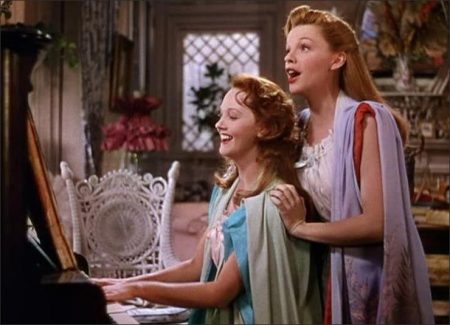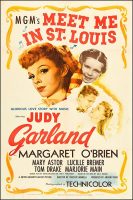Meet Me in St. Louis movie storyline. In St. Louis, Missouri in the summer of 1903, seventeen-year-old Esther Smith fantasizes about meeting John Truett, the shy boy-next-door, while her older sister Rose frets about her beau, Warren Sheffield, who is off at Yale.
Sure that Warren, who is calling Rose at 6:30 p.m. that evening, is finally going to propose to her sister, Esther arranges with Katie, the Smiths’ housekeeper, for the family to eat dinner early, so that Rose will have some privacy while talking on the telephone. Esther’s cantankerous father Alonzo, who has not been told about the expected call, ruins her plan, however, when he insists on eating at the usual time.
During dinner, everyone, including Esther’s five-year old sister “Tootie,” tries to hurry Lon along, but the phone rings just as the main course is being served. As her family eavesdrops on the entire conversation, Rose attempts to prod Warren into a proposal, but he gets mired in small talk and hangs up without uttering a single romantic word. Later, at Esther’s urging, Rose invites John to a farewell party for her older brother Lon, Jr., who is going to Princeton.
At the party, Esther at first feigns indifference to John, but hides his hat to keep him at the house and then asks him to help her turn off all the lights. Although John is clearly attracted to the flirtatious Esther, he is too shy to kiss her, and instead gives her a hearty handshake. Before he leaves, Esther invites him to join her family that Sunday for a tour of the St. Louis Exposition fairgrounds, and he tentatively accepts.
On Sunday, Esther waits eagerly for John at the trolley stop, but he has not arrived by the time the trolley is scheduled to leave. As the trolley is pulling away, however, John appears and, to Esther’s joy, hops on next to her.
Meet Me in St. Louis is a 1944 American Technicolor musical film made by Metro-Goldwyn-Mayer. Divided into a series of seasonal vignettes, starting with Summer 1903, it relates the story of a year in the life of the Smith family in St. Louis, leading up to the opening of the Louisiana Purchase Exposition (more commonly referred to as the World’s Fair) in the spring of 1904.[4][5] The picture stars Judy Garland, Margaret O’Brien, Mary Astor, Lucille Bremer, Tom Drake, Leon Ames, Marjorie Main, June Lockhart, and Joan Carroll.
The film was adapted by Irving Brecher and Fred F. Finklehoffe from a series of short stories by Sally Benson, originally published in The New Yorker magazine under the title “5135 Kensington”, and later in novel form as Meet Me in St. Louis. The film was directed by Vincente Minnelli, who met Garland on the set and later married her. It was the second-highest grossing picture of 1944, only behind Going My Way.[6] In 1994, the film was deemed “culturally significant” by the Library of Congress and selected for preservation in the United States National Film Registry.
Garland debuted the standards “The Trolley Song”, “The Boy Next Door”, and “Have Yourself a Merry Little Christmas”, all of which became hits after the film was released. Arthur Freed, the producer of the film, also wrote and performed one of the songs.
Film Review for Meet Me in St. Louis
Meet Me In St. Louis (1944) is a delightful, classic, nostalgic, poignant, and romanticized musical film – and one of the greatest musicals ever made. It tells the story of a turn-of-the-century family in suburban, midwestern St. Louis of 1903, who live in a stylish Edwardian home at 5135 Kensington Avenue.
The city, and the well-to-do Smith family (with four beautiful daughters), is on the verge of hosting (and celebrating) the arrival of the spectacular 1904 World’s Fair. However, the family’s head of the house is beckoned to New York due to a job promotion – an uprooting move that threatens to indelibly change the lives of the family members forever. Filmed during WWII, the decision to remain in St. Louis in the film’s conclusion affirmed that nothing will be altered for the American family.
This gem of cinematic, picture-postcard Americana and youthful romance, is richly filmed in Technicolor. It marked the beginning of the golden age of MGM musicals (and producer Arthur Freed’s unit), and ultimately became the second most successful film for MGM (behind Gone With the Wind (1939)).
The story is based on the book of the same name from Sally Benson’s memoirs of her life in St. Louis, Missouri from 1903-4 – they were recalled and written in multiple issues of The New Yorker Magazine from 1941-1942 (originally published under the title “5135 Kensington” and eventually gathered together as The Kensington Stories).
The charming stories, a dozen in all to represent each of the twelve months of the year, are expressed in the film in its musical numbers. The film abandoned the ‘put-on-a-show’ mentality of so many other backstage song/dance films. Its songs and wonderful performances are carefully and naturally integrated into the story of the close-knit family’s day-to-day life, and serve to advance the action and plot from one season to the next.
Meet Me in St. Louis (1944)
Directed by: Vincente Minnelli
Starring: Judy Garland, Margaret O’Brien, Mary Astor, Lucille Bremer, Leon Ames, Tom Drake, Marjorie Main, Harry Davenport, June Lockhart, Henry H. Daniels Jr., Joan Carroll, Hugh Marlowe
Screenplay by: Irving Brecher, Fred F. Finklehoffe
Cinematography by: George J. Folsey
Film Editing by: Albert Akst
Costume Design by: Irene Sharaff
Set Decoration by: Edwin B. Willis
Art Direction by: Lemuel Ayers, Cedric Gibbons, Jack Martin Smith
Music by: Roger Edens, Conrad Salinger
Distributed by: Loew’s, Inc.
Release Date: November 28, 1944
Views: 248





